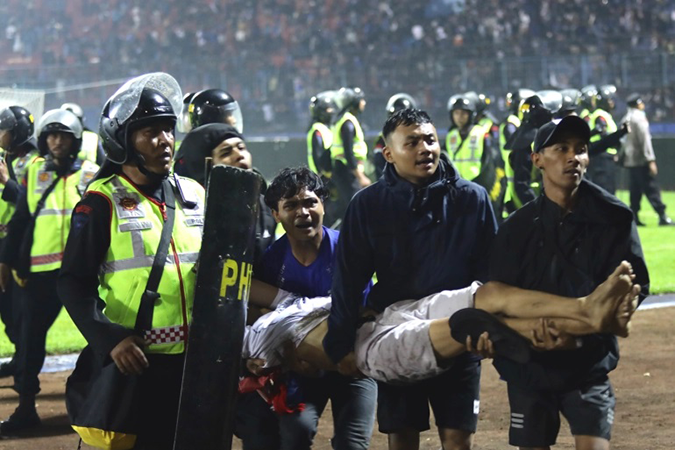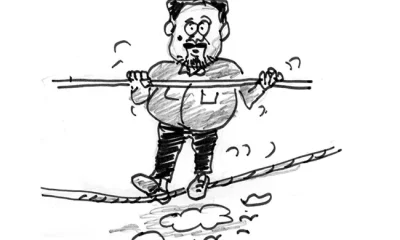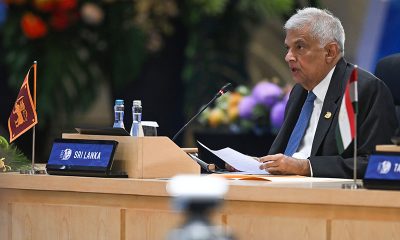News
Hundreds killed, hurt in stampede at Indonesia football match

Police fire tear gas after fans invade pitch in East Java, triggering a stampede that killed at least 174 people and injured 100 more
(Al Jazeera) At least 174 people have been killed and dozens more injured in a riot and a stampede at an Indonesian football stadium.The tragedy on Saturday night in the eastern city of Malang was one of the world’s deadliest sporting stadium disasters.Police in East Java province said thousands of fans of Arema FC stormed the pitch at Kanjuruhan Stadium after their team lost 3-2 to Persebaya Surabaya. Officers tried to control the “riots” by firing tear gas, triggering a stampede as panicked fans rushed to an exit gate.
Some suffocated in the chaos while others were trampled to death. At least 34 people, including two police officers, died at the stadium.East Java’s Vice Governor Emil Dardak told Kompas TV in an interview on Sunday afternoon that the death toll has climbed to 174, while more than 100 injured people were receiving intensive treatment in eight hospitals. Eleven of them were in critical condition, he said.
“At 9:30am (0230 GMT) the death toll was 158, at 10:30am the figure rose to 174 deaths,” Dardak said.A hospital director told local television that one of the victims was five years old.Video footage from local news channels showed fans streaming onto the pitch in the Kanjurujan Stadium in Malang after Arema FC lost to Persebaya Surabaya. Scuffles can be seen, with what appeared to be tear gas in the air. Images also showed people who appeared to have lost consciousness being carried away by other fans.
The stadium holds 42,000 people and authorities said it was a sell-out. Police said about 3,000 people had stormed the pitch. Vehicles outside the stadium were also torched, including at least five police cars and trucks.Survivors described panicking spectators in a packed crowd as tear gas rained down on them.
“Officers fired tear gas, and automatically people were rushing to come out, pushing each other and it caused many victims,” a 43-year-old spectator told the AFP news agency. “Nothing was happening, there was no riot. I don’t know what the issue was, they suddenly fired tear gas. That’s what shocked me, didn’t they think about kids, women?”
President Joko Widodo ordered an investigation into the tragedy, a safety review into all football matches and directed the country’s football association to suspend all matches until “security improvements” were completed.
“I deeply regret this tragedy and I hope this football tragedy will be the last in our country,” Widodo said.
Meanwhile, FIFA President Gianni Infantino said the the football world was “in a state of shock”.
“All our thoughts and prayers are with the victims, those who have been injured, together with the people of the Republic of Indonesia,” he added.
Fan violence is an enduring problem in Indonesia, with a strong rivalry between clubs sometimes leading to violence among supporters. Arema FC and Persebaya Surabaya are longtime rivals and the latter’s fans were not allowed to buy tickets for Saturday’s game due to fears of violence.
Indonesia’s coordinating minister for political, legal and security affairs, Mahfud MD, said organisers had ignored authorities’ recommendation to hold the match in the afternoon instead of the evening. He also said the government had recommended only 38,000 tickets be printed, but there was instead a sell-out crowd of 42,000. “The government has made improvements to the implementation of football matches… and will continue to improve. But this sport, which is a favourite of the wider community, often provokes supporters to express emotions suddenly,” he said in an Instagram post.
World soccer’s governing body FIFA specifies in its safety regulations that no firearms or “crowd control gas” should be carried or used by stewards or police. East Java police did not immediately respond to a request for comment on whether they were aware of such regulations.Referring to the FIFA rules, Amnesty International criticised the use of tear gas in the stadium and urged authorities to “conduct a swift, thorough, and independent investigation” and “ensure that those who are found to have committed violations are tried in open court and do not merely receive internal or administrative sanctions”.
“This loss of life cannot go unanswered,” said Usman Hamid, the executive director of Amnesty International Indonesia.
The Football Association of Indonesia (PSSI) said it would send its own investigation team to Malang to establish the cause of the crush. It also banned Arema FC from hosting home games for the rest of the season.
“We’re sorry and apologise to families of the victims and all parties over the incident,” PSSI Chairman Mochamad Iriawan said.
The tragedy comes as Indonesia is scheduled to host the FIFA U-20 World Cup in May and June next year. They are also one of three countries bidding to stage next year’s Asian Cup, the continent’s equivalent of the Euros, after China pulled out as host.Al Jazeera’s Jessica Washington, reporting from the Indonesian capital, Jakarta, said Saturday’s disaster was “historic”.
“Violence and riots are a common occurrence at football matches in Indonesia, but we have never seen something like this before,” she said.
“This is a historic tragedy, not only for football in Indonesia but football internationally. This is one of the biggest tragedies the sport has seen, in terms of fan violence, in terms of deaths of fans at a match,” she added.
Other stadium disasters include a 1964 crush at a Peru-Argentina Olympic qualifier at Lima’s National Stadium that killed some 320 people, and the 2012 Port Said stadium tragedy in Egypt where 74 people died in clashes.In 1989, some 96 Liverpool supporters were crushed to death in the United Kingdom, when an overcrowded and fenced-in enclosure collapsed at the Hillsborough Stadium in Sheffield.
Latest News
Laugfs LPG to cost more

Laugfs Gas PLC, has increased its price of domestic Liquefied Petroleum Gas (LPG).
Accordingly,
The price of a 12.5 kg cylinder has been increased by Rs. 420 to Rs. 4,100
The price of a 5kg cylinder of Laugfs LPG has been increased by Rs.168 to Rs.1,645.
Latest News
Petrol prices reduced by Rs. 10 from midnight today [31]

The Ceylon Petroleum Corporation (CPC) has announced a reduction in the prices of petrol by Rupees Ten, with effect from midnight tonight (31st March 2025).
Accordingly, the new fuel prices are as follows:
Petrol Octane 92 – Rs. 299
Petrol Octane 95 – Rs. 361
Auto Diesel – Rs. 286
Kerosene – Rs. 183
Super diesel – Rs. 331
News
Ramadan is a time to share the profound message of generosity, and compassion with the World – PM

Prime Minister Dr Harini Amarsuriya in her Ramadan message says that Ramadan is a time to share the profound message of generosity, and compassion with the World.
The full text of the Prime Ministers Ramadan Message:
“As our Islamic brothers and sisters in Sri Lanka and around the world celebrate the sacred month of Ramadan, I extend my heartfelt greetings and best wishes for peace, prosperity, and spiritual fulfillment.
Ramadan is a time of deep reflection, prayer, and self-discipline. It is a period that teaches us the values of compassion, generosity, and unity. Fasting during this holy month is not only an act of devotion but also a reminder of the struggles faced by those less fortunate. It is a time to cultivate patience, humility, and gratitude while strengthening our bonds with family, friends, and the community.
At its core, Ramadan embodies the spirit of kindness, forgiveness, and charity. The practice of Zakat and Sadaqah during this time highlights the importance of sharing with those in need and reinforcing the principle that true prosperity lies in giving and uplifting others. These values are universal and resonate deeply with all communities, fostering harmony and understanding among people of different faiths and backgrounds.
Sri Lanka is a nation rich in diversity, and it is through mutual respect and solidarity that we continue to strengthen our collective future. The spirit of Ramadan reminds us of the need for coexistence, tolerance, and the pursuit of justice and peace.
As the month of fasting culminates in the joyous celebration of Eid, let us carry forward the lessons of Ramadan—compassion, unity, and selflessness—into our daily lives. May this blessed month bring peace to our hearts, our homes, and our nation.
Ramadan Mubarak!”
-

 Sports2 days ago
Sports2 days agoSri Lanka’s eternal search for the elusive all-rounder
-

 Features6 days ago
Features6 days agoCelebrating 25 Years of Excellence: The Silver Jubilee of SLIIT – PART I
-

 Business6 days ago
Business6 days agoCEB calls for proposals to develop two 50MW wind farm facilities in Mullikulam
-

 Business4 days ago
Business4 days agoAIA Higher Education Scholarships Programme celebrating 30-year journey
-

 News3 days ago
News3 days agoGnanasara Thera urged to reveal masterminds behind Easter Sunday terror attacks
-

 Features6 days ago
Features6 days agoNotes from AKD’s Textbook
-

 News2 days ago
News2 days agoComBank crowned Global Finance Best SME Bank in Sri Lanka for 3rd successive year
-

 Features2 days ago
Features2 days agoSanctions by The Unpunished





















